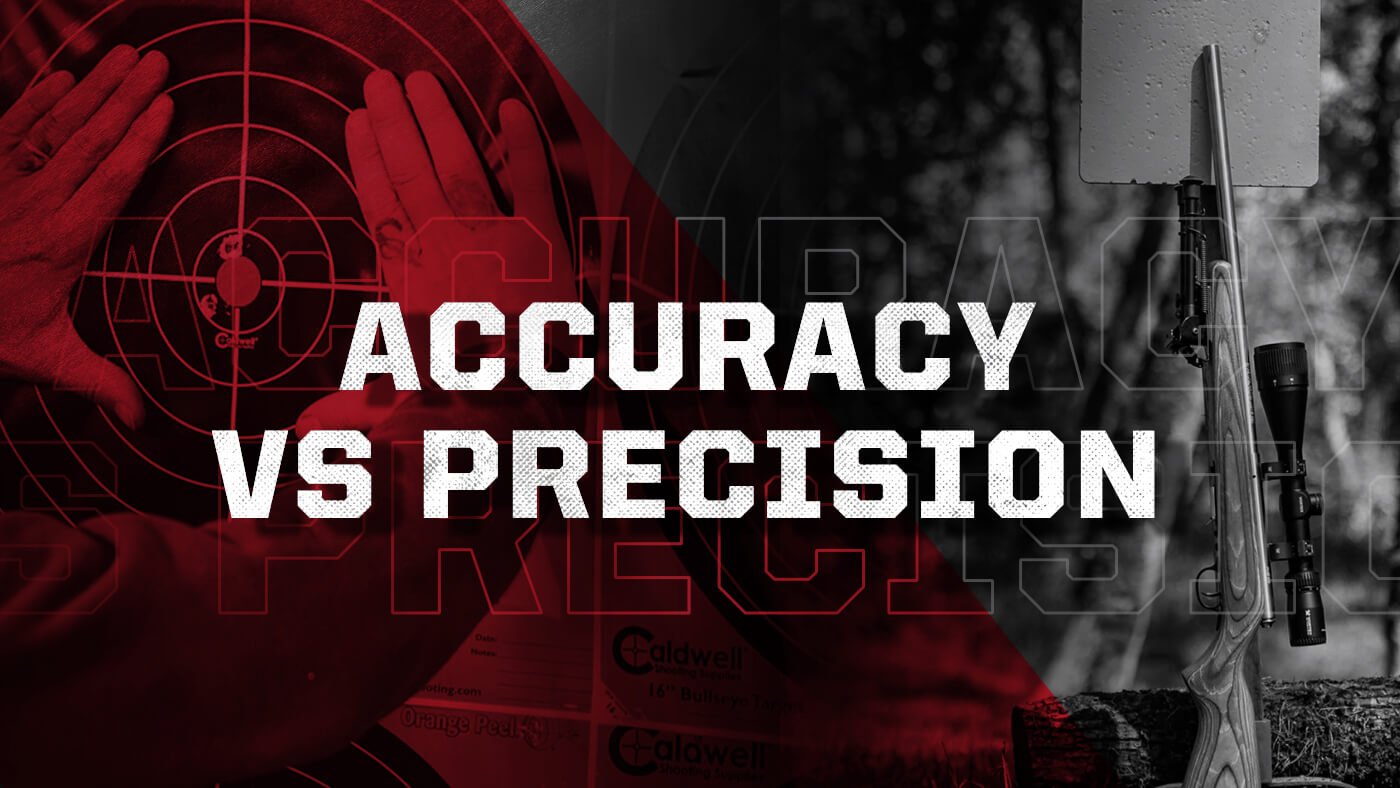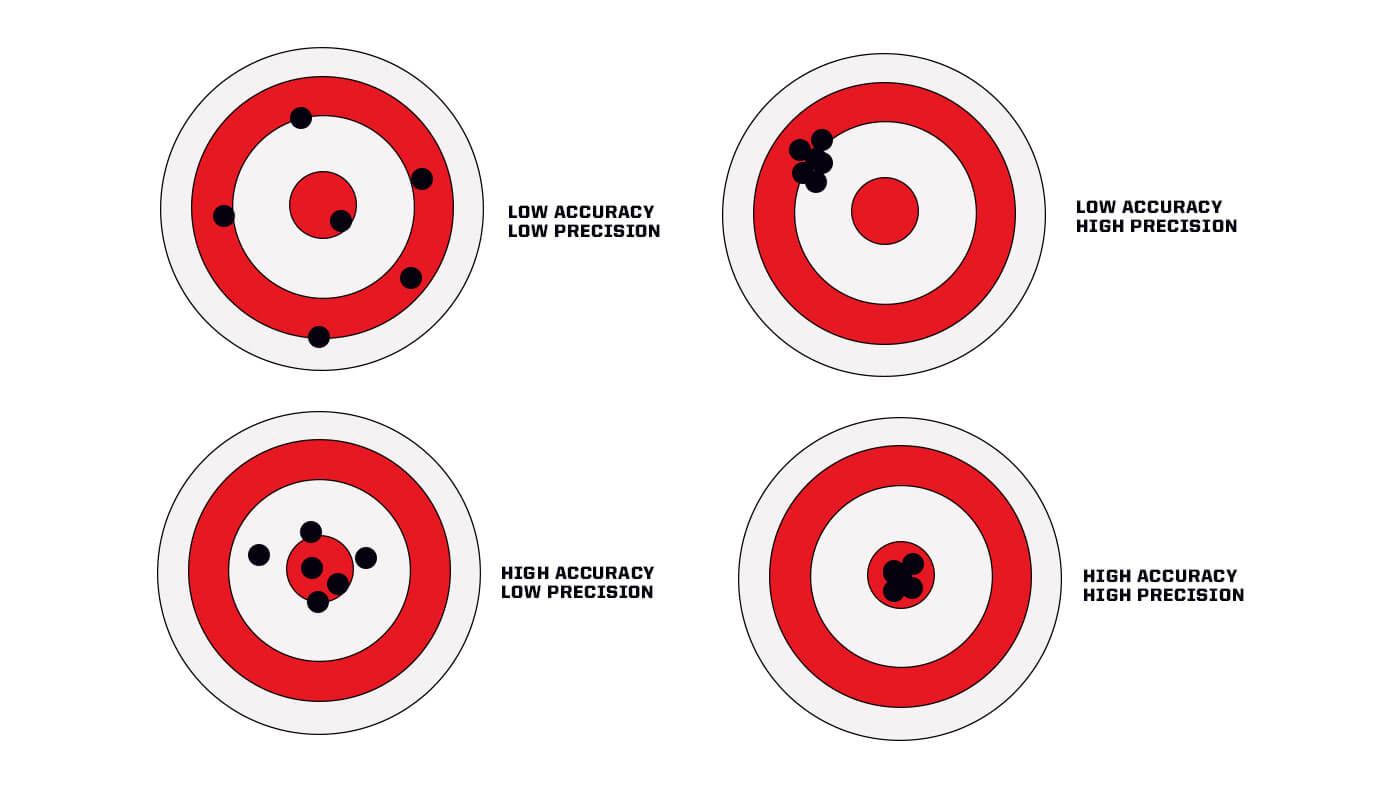- Savage Blog
- Understanding The Difference Between Accuracy and Precision
Understanding The Difference Between Accuracy and Precision

In the world of firearms and shooting, two terms frequently come up in discussions about performance: accuracy and precision. While they are often used interchangeably in casual conversation, they represent distinct concepts that are crucial for both novice and experienced shooters to understand. This blog will delve into the difference between accuracy and precision, why it matters, and how it impacts shooting performance.

Defining Accuracy vs Precision
Accuracy
Accuracy refers to how close a shot (or a series of shots) is to the intended target or bullseye. When we say a firearm is accurate, we mean that it consistently hits the target close to the point of aim. Accuracy is a measure of correctness, indicating the degree to which the average shot hits the target center.
For example, if you're aiming at the bullseye of a target and your shots are landing near the bullseye, your shooting is accurate. Accuracy can be affected by various factors including the shooter's skill, the quality of the firearm and ammunition, environmental conditions, and the quality of the sights or optics being used.
Precision
Precision, on the other hand, refers to the consistency of shots. It is the measure of how close the shots are to each other, regardless of whether they hit the intended target. Shooters will often measure precision in “groups” of 3 to 5 shots to judge the precision of the firearm they are shooting. Precision is about the repeatability of your shots. A shooter is precise if their shots consistently land in the same spot, even if that spot is not the bullseye.
For instance, if your shots consistently hit a small area on the target but are not near the bullseye, your shooting is precise but not accurate. Precision is influenced by the firearm's inherent characteristics, the stability and consistency of the shooter's stance and grip, the shooter’s trigger control, and the consistency of the ammunition used.
The Importance of Understanding Both
Understanding the difference between accuracy and precision is crucial for diagnosing shooting problems and improving performance. A shooter might struggle with accuracy but have excellent precision, indicating a need to adjust their sights or aiming technique. Conversely, a shooter with good accuracy but poor precision might need to focus on consistency in their shooting form and technique.
Practical Examples
Accurate but Not Precise: Imagine a scenario where you aim at the bullseye and your shots are spread out around the bullseye. The average position of your shots is close to the bullseye, indicating accuracy, but the shots are not clustered together, showing a lack of precision.
Precise but Not Accurate: In another scenario, you aim at the bullseye but all your shots land in a tight cluster to the left of the target. Here, the shots are precise because they are grouped together, but they are not accurate because they miss the bullseye.
Accurate and Precise: Ideally, you want your shots to form a tight cluster around the bullseye. This indicates both accuracy and precision, meaning you are consistently hitting your target and the shots are closely grouped together.
Neither Accurate nor Precise: If your shots are scattered all over the target with no discernible pattern or clustering, you are neither accurate nor precise. This indicates a need for significant improvement in both aim and consistency.

Factors Affecting Accuracy and Precision
Firearm Quality
The quality of the firearm itself plays a significant role in both accuracy and precision. High-quality firearms are manufactured to tighter tolerances and are often capable of better performance. Factors such as barrel length, rifling, trigger mechanism, and the overall build quality can all impact how accurately and precisely a firearm can shoot.
Savage takes firearm quality seriously, and its why firearms such as the Model 110 have continued to be popular choices with both hunters and shooters for decades. Every firearm from a 110 Elite Precision to a Mark II rimfire is made to precise standards, so these rifles can do their part to offer a precision shooting experience out of the box.
Precision manufacturing ensures that Savage rifles come from the factory capable of superior accuracy and precision. Savage centerfire rifles come standard with floating bolt heads, including the Model 110, Axis, Model 25, and the Impulse. Floating bolt heads are separate a separate piece from the rest of the bolt, allowing the head to float freely and fully engage the head of the cartridge case and provide consistent pressure on the cartridge. Centerfire rifles, as well as the A and B series rimfire rifles, come with exact headspace control set to the minimum headspace possible for the best fit and tightest tolerances in achieving accuracy. Precision rifling is also important, and Savage has mastered the art of button rifling. Each Savage rifle barrel is rifled to have a consistent diameter and twist rate down the length of the barrel. Each barrel is also hand straightened after machining and rifling to ensure they are perfectly straight while also helping to reduce the windage adjustments needed when zeroing your rifle.
Finally, select Savage models come with factory blueprinting. Blueprinting is a process in which the action and the bore are perfectly aligned to be concentric with each other, creating consistent shot-after-shot accuracy. Factory blueprinting comes with tighter tolerances, more precise measurements, and gives the custom shop treatment to select Savage factory rifles.

Ammunition
The type and quality of ammunition can also influence shooting performance. High-quality, consistent ammunition contributes to better precision. Different types of ammunition might perform better or worse in certain firearms, so it’s often necessary to test various options to find what works best for your particular setup. Once you find an ammunition loading that is both accurate and precise with your firearm, make sure you continue to use that same brand and type of ammo whenever possible.
Some key aspects of ammunition to note include the bullet weight and bullet type (hollow point, soft point, full metal jacket, etc.). If you cannot find the same ammunition brand you typically shoot out of your firearm, try to find ammunition that has a similar bullet type and weight to what you normally shoot. Nearly all ammunition brands will list their bullet weights and type of bullet on the box, making it easy to remember what ammunition characteristics you are looking for to maintain the proper accuracy and precision.
Shooter Skill
A shooter’s skill level and experience are critical components. Proper shooting techniques, such as maintaining a steady aim, proper grip, controlled breathing, and smooth trigger pull, all contribute to both accuracy and precision. Regular practice and training are essential for developing and maintaining these skills.
Environmental Conditions
External factors like wind, temperature, and humidity can affect bullet trajectory and impact point, influencing both accuracy and precision. Understanding and compensating for these conditions is part of what separates novice shooters from more experienced ones. These factors will be more prevalent and have a greater effect on your shooting at longer ranges.
Equipment and Accessories
The sights or optics used on a firearm significantly impact accuracy. Properly zeroed sights ensure that the point of aim corresponds with the point of impact. Additionally, using shooting supports like bipods or sandbags can help stabilize the firearm, improving precision.
The ergonomic properties of a firearm can also significantly impact accuracy and precision. Savage’s AccuFit stock provides adjustability for both comb height and length of pull, helping provide a precise, comfortable fit for each shooter using the firearm. Better fitting firearms lead to more comfortable shooting, which helps the shooter focus on their fundamentals and the target.

Learn more about Savage’s AccuFit stock
Improving Accuracy and Precision
Focus on Fundamentals
Improving both accuracy and precision begins with mastering the basics. Consistent practice, focusing on proper stance, grip, sight alignment, and trigger control, is fundamental. Dry firing exercises (practicing without live ammunition) can help improve trigger discipline and sight alignment.
Performance innovations like the Savage AccuTrigger help shooters get the fundamentals down faster. The AccuTrigger’s lightweight adjustments and safety blade help provide a trigger that is easy to take up and light and crisp when pulled, allowing shooters to better be able to hone the fundamental trigger control that is necessary for both accurate and precise shooting. AccuTrigger is also a safety feature, with the safety blade at the front of the trigger blocking the connection between the sear and the trigger until it is intentionally depressed. This helps stop accidental discharges from unintentional trigger pulls and dropping the firearm.

Learn more about Savage’s AccuTrigger
Regular Practice
Shooting is a skill that requires regular practice. Frequent trips to the range, combined with structured training sessions, can help reinforce good habits and improve both accuracy and precision over time.
Use of Quality Equipment
Investing in quality firearms, ammunition, and accessories pays off in improved shooting performance. While quality equipment can be more expensive, the benefits in terms of reliability and performance are often worth the investment. With Savage, investing in quality doesn’t have to mean a hefty price tag. Even in our more affordable firearms, quality innovations in design, manufacturing, and performance come standard. We’re focused on delivering Better Comes Standard at Savage with every firearm we make.
Quality equipment comes with quality innovations. Savage’s AccuStock enhances accuracy and precision from the firearm by bedding the action with an integrated aluminum chassis in the stock. The system allows for the action to have continuous contact along the length of the stock’s forend, as well providing pressure from multiple directions. The result is a more rigid stock and action that doesn’t shift or expand from heat, torque, and recoil, resulting in more consistent and precise shooting.
Professional Training
Consider taking lessons from a qualified instructor. Professional training can provide valuable insights by looking at aspects of your shooting form and fundamentals and recommending changes to improve your performance. Instructors will often pick up on habits or other issues that may affect your shooting performance, and they can be extremely helpful to new and experienced shooters alike.

Conclusion
Understanding the difference between accuracy and precision is crucial for any shooter aiming to improve their performance. Accuracy is about hitting the intended target, while precision is about the consistency of your shots. Both are essential for effective shooting, and each requires attention to different aspects of technique and equipment.
By focusing on mastering the fundamentals, practicing regularly, using quality equipment, and seeking professional training, shooters can enhance both their accuracy and precision, leading to better overall performance. Whether for sport, hunting, or self-defense, the pursuit of accuracy and precision is a journey that requires dedication, practice, and continuous learning.


